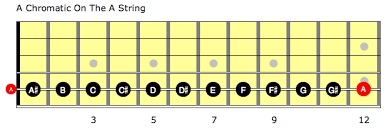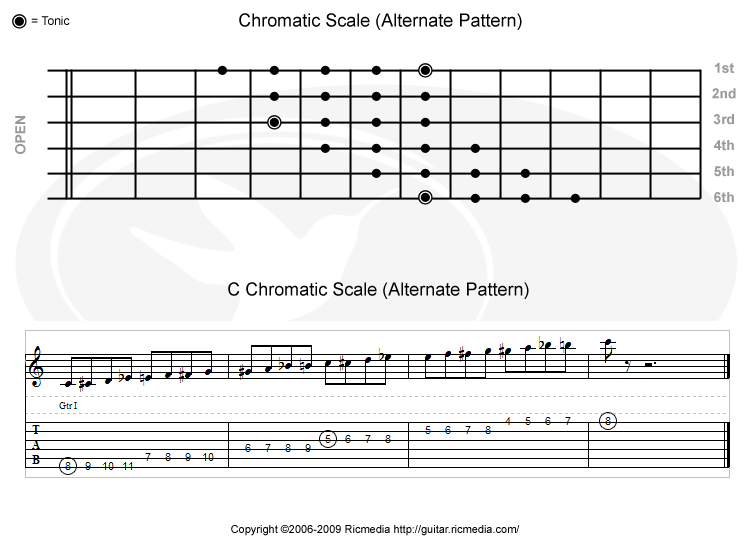

Scale Patterns
There is no need to memorize a bunch of patterns for minor scales, major pentatonic scales and minor pentatonic scales because those can all be derived from their related major scales. Memorize the five major scale patterns from CAGED. The same set of five major scale patterns is depicted by both the graphics below. The first one shows strings as vertical lines while the second graphic shows the strings as horizontal lines:


In either set above, colored dots (as opposed to black dots) indicate root notes. Recalling the five CAGED major scale forms, we know Pattern 1 above as the E Form, Pattern 2 as the D Form, Pattern 3 as the C Form, Pattern 4 as the A Form and Pattern 5 as the G Form. The number identifying each shape above is its EDCAG Position, also defined earlier in this lesson.
Major Pentatonic Scale Patterns
The CAGED Chart illustrates the five major pentatonic scale patterns from CAGED. For each of them, you can see how similar it is to the corresponding major scale pattern. Derivation of the major pentatonic scale pattern from its corresponding major scale pattern is easy: Simply omit scale degrees 4 and 7 from the major scale, retaining only the root and degrees 2, 3, 5 and 6 from the major scale. Now there are only five distinct scale degrees, so it’s a pentatonic scale.
Relative Minor Scale Pattern
One of the most useful minor scales is Aeolian mode, also known as the Natural minor scale. A fingering pattern for Aeolian mode is easily derived from a pattern for Ionian mode simply by “shifting” the root notes (and all the other scale degrees) while retaining the same fingering pattern and fretboard position. The most common “shift” is the concept of the Relative Minor. For example, the key of Am is the relative minor for the key of C. So, all the notes in the major scale pattern for a C major scale are the same set of notes comprising the A minor scale (natural minor scale, to be precise). This article is probably a better explanation of scale shifting to get a relative minor from a major scale: https://appliedguitartheory.com/lessons/relative-major-relative-minor-scales/.
Applying CAGED to All Seven Modes
In Lesson 3 we learned the Ionian mode is the same thing as the major scale. In addition to Aeolian mode, there are five more modes that can also be derived from Ionian mode. Recall this from Lesson 3:
|
Mode Name |
Pattern (Whole & Half steps) |
|
Ionian |
W-W-H-W-W-W-H |
|
Dorian |
W-H-W-W-W-H-W |
|
Phrygian |
H-W-W-W-H-W-W |
|
Lydian |
W-W-W-H-W-W-H |
|
Mixolydian |
W-W-H-W-W-H-W |
|
Aeolian |
W-H-W-W-H-W-W |
|
Locrian |
H-W-W-H-W-W-W |
The following chart illustrates comprehensively the scale shifting concept described earlier (i.e., shifting the sequence of scale degrees while retaining the same fingering pattern and fretboard position). The scale roots are shown as pink dots. By treating this chart as a matrix of seven rows and five columns, pick any column and note how the same fingering pattern is used to play all seven modes:

Minor Pentatonic Scale Patterns
Derivation of the minor pentatonic scale from a minor scale (either Aeolian mode or Dorian mode) is easy: Simply omit scale degrees 2 and 6 from the minor scale, retaining only the root and degrees 3, 4, 5 and 7 from the minor scale. Now there are only five distinct scale degrees, so it’s a pentatonic scale. Another way to derive a minor pentatonic scale is to apply the relative minor “shift” to a major pentatonic scale. For example, all the notes in the pattern for a C major pentatonic scale are the same set of notes comprising the A minor pentatonic scale.
Of course, another way to learn pentatonic scale patterns is to memorize fretboard patterns without regard for how those scales can be derived, as shown by this video lesson by Rick Beato: https://www.youtube.com/watch?v=nKFiEhaMGaU. (He refers to various minor pentatonic scale shapes simply as “position 1”, “position 2”, etc. But it would be more precise, in my opinion, to refer to those shapes as EDCAG position 1, EDCAG position 2, etc.)
Diagonal Shapes For Pentatonics
All the scale patterns shown so far are considered “box" shapes because they’re each deliberately confined to a small area along the length of the fretboard. This encourages efficient technique by requiring minimal left hand movement to play the pattern. However, for major and minor pentatonic scales there are alternative “diagonal” shapes that are very popular as a short-cut for learning how to improvise guitar solos.
Shown here are six fretboard diagrams arranged into two columns with the left column showing shapes for A Minor pentatonic and the right column showing shapes for C Major pentatonic. The top diagram in each column shows interconnected box shapes from CAGED methodology. Below those are equivalent diagonal shapes typically played using only fingers 1 and 3 on the fretting hand:

For most intermediate-level guitarists diagonal pentatonic scale shapes are easy and fun to play. However, beware of the trap some aspiring lead guitarists fall into: As they become more confident with their improvisation skills, they become complacent with reliance on diagonal pentatonic patterns exclusively, thus neglecting other techniques for creating original solos.
Reviewing the Major Scale
The article at https://appliedguitartheory.com/lessons/major-scale/ is a useful comprehensive lesson on the Major Scale and the scale patterns for it. The author identifies the five CAGED major scale forms as “position 1”, “position 2”, etc. But it would be more precise, in my opinion, to refer to the five CAGED major scale forms as either (1) E form, D form, etc., or (2) EDCAG position 1, EDCAG position 2, etc.
Another alternative lesson on the Major Scale and scale patterns for it is at https://www.guitarlessonworld.com/lessons/major-scale/ but don't study the Single Octave Patterns or the Major Scale Box Patterns because they're just CAGED forms with unusual names such as "6-4 Single Octave Pattern" and "6-4 Box Pattern".
“Three Notes Per String” is an alternative to CAGED I don’t teach: https://appliedguitartheory.com/lessons/3-notes-per-string-major-scale-patterns/.
Nor do I teach this other alternative to CAGED also based on 7 “positions” (i.e., 7 forms): https://jenslarsen.nl/major-scale-7-positions-berklee-system/.
Chromatic Scale Patterns
You should already know this is one way to play a chromatic scale:

Here's another way to play a chromatic scale. This pattern is more useful, as a fingering exercise if nothing else:
